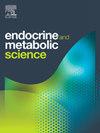印度一家三级医疗中心内科重症监护室糖尿病酮症酸中毒的流行病学模式及其不良后果的相关因素
Q3 Medicine
引用次数: 0
摘要
目的糖尿病酮症酸中毒(DKA)是糖尿病的一种可怕并发症,以高血糖、酮症和代谢性酸中毒三联生化反应为特征。在印度次大陆,DKA 的临床流行病学模式和结果在很大程度上尚未得到研究,但了解这些情况对于优化管理策略至关重要。从病例档案中提取了患者的人口统计学特征、临床病史、实验室检查结果、诱发因素和重症监护管理。临床结果分为出院或死亡。结果患者的平均年龄为41.54(16)岁;77人(55.79%)为女性,56.52%为1型糖尿病患者,23.19%为2型糖尿病患者,20.29%为胰源性糖尿病患者。感染(21.02%)和胰腺炎(21.01%)是诱发 DKA 的常见原因。严重程度通过 pH 值、阴离子间隙和碳酸氢盐水平进行评估。总死亡率为 11.59%。与死亡率明显相关的因素包括年龄 60 岁、既往 3 次 DKA 发作、低钾血症、血清肌酐升高和感觉改变。本文章由计算机程序翻译,如有差异,请以英文原文为准。
Epidemiologic pattern and factors associated with adverse outcomes of diabetic ketoacidosis in medical intensive care units of a tertiary care centre in India
Aim
Diabetic ketoacidosis (DKA) is a dreadful complication of diabetes mellitus characterized by a biochemical triad of hyperglycemia, ketosis, and metabolic acidosis. The clinic-epidemiologic pattern and outcomes of DKA in the Indian subcontinent are largely unexplored, yet understanding them is crucial for optimizing management strategies.
Methods
A total of 138 patients admitted with a DKA diagnosis were reviewed retrospectively over two years. Patient demographics, clinical history, laboratory findings, precipitating factors, and intensive care management were extracted from case files. Clinical outcomes were classified as either discharge or death. Data analysis was performed using SPSSv29.
Results
The mean age of the patients was 41.54 (16) years; 77 (55.79 %) were female, 56.52 % had type 1, 23.19 % had type 2, and 20.29 % had pancreatic diabetes. Non-compliance with infection (21.02 %), and pancreatitis (21.01 %) were common DKA triggers. Severity was assessed by pH, anion gap, and bicarbonate levels. The overall mortality rate was 11.59 %. Factors significantly associated with mortality included age >60 years, >3 previous DKA episodes, hypokalaemia, elevated serum creatinine, and altered sensorium.
Conclusion
These findings emphasize the importance of demographics and risk factors in assessing DKA mortality risk, aiding early identification and targeted interventions for high-risk patients.
求助全文
通过发布文献求助,成功后即可免费获取论文全文。
去求助
来源期刊

Endocrine and Metabolic Science
Medicine-Endocrinology, Diabetes and Metabolism
CiteScore
2.80
自引率
0.00%
发文量
4
审稿时长
84 days
 求助内容:
求助内容: 应助结果提醒方式:
应助结果提醒方式:


